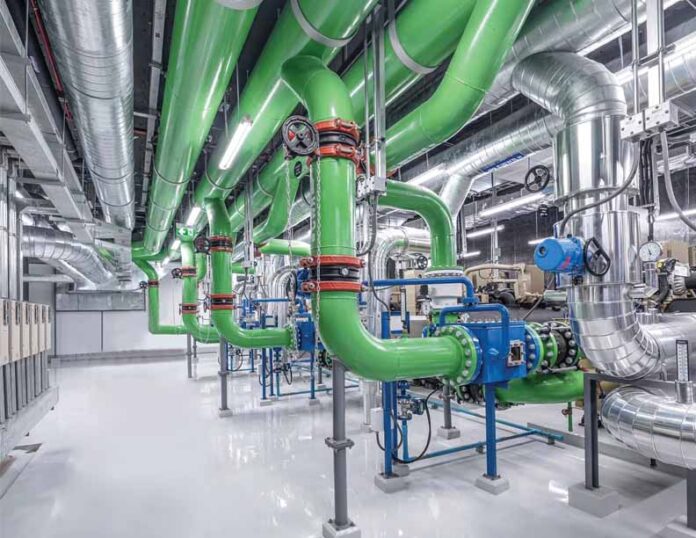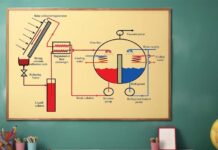
As ever-growing global warming is leading to an increased demand for sustainable cooling solutions, the need for a modernised HVAC-R industry is growing. More extreme weather and compliance pressure to develop energy-efficient, sustainable technologies & refrigerants will continue to push the demanding situation further. Consumer demand for environmentally friendly solutions will go on adding challenges, which will create significant opportunities for innovation and expansion within the HVAC-R sector.
Higher temperatures directly increase the demand for air conditioning and refrigeration services in residential, commercial and industrial setups. Urban areas experiencing ‘urban heat island’ effects require more robust and efficient cooling solutions. Growing environmental concerns and regulations push the development and adoption of energy-efficient HVAC-R systems. The increasing frequency of extreme weather events necessitates the development of climate-resilient and adaptive HVAC-R technologies. Stricter environmental standards and initiatives promoting sustainable buildings and infrastructure are accelerating the transition to greener HVAC-R solutions.
What’s up in the HVAC-R industry now?
The growing complexity of HVAC-R systems and the need for maintenance and installation of new technologies are increasing the demand for skilled technicians.
Manufacturers are developing innovative solutions, including AI-powered HVAC-R systems, innovative filter designs, and more efficient insulation techniques.
Businesses are focusing on sustainable practices throughout the HVAC-R value chain, from manufacturing to the use of lower-carbon energy and materials.
Emerging challenges that need redressal
Emerging challenges in HVAC-R management include a significant labour shortage; the rapid adoption of new A2L refrigerants requiring updated safety training; escalating costs for sustainable systems and skilled labour, navigating complex & evolving environmental regulations; and integrating advanced technologies like AI & IoT into existing infrastructure.
Other challenges involve ensuring cybersecurity for connected systems, managing power grid inconsistencies, and developing specialised cooling solutions for high-heat environments like data centres.
Let us see the challenges category-wise:
Skilled labour shortage
- Retiring experts: Many experienced technicians are retiring, leading to a loss of institutional knowledge.
- Requirement of developing new skills: The increasing complexity of HVAC-R systems demands advanced technical skills, creating a gap between available workers and job requirements.
Sustainability and regulatory pressures
- Refrigerant phase-outs: Regulations are phasing out high-Global Warming Potential (GWP) refrigerants, requiring a shift to new, mildly flammable A2L refrigerants.
- A2L refrigerant handling: The new refrigerants require updated safety protocols, specialised tools, and comprehensive technician training.
- Energy efficiency standards: Evolving energy efficiency regulations necessitate more sophisticated and costly HVAC-R systems.
Technological integration
- Smart system adoption: Integrating AI, IoT, and advanced building automation systems requires investment in new equipment and a skilled workforce to manage them.
- Cybersecurity: As HVAC-R systems become more connected, they present increased vulnerabilities to cyber threats that must be addressed.
- Data management: Smart systems generate vast amounts of data, requiring robust data privacy and management protocols to ensure compliance.
Operational and cost challenges
- High costs: The investment in new technologies, sustainable equipment, and specialised training is a significant financial burden, especially for smaller businesses.
- Supply chain disruptions: The transition to new refrigerants and technologies can create supply chain pressures, affecting availability and pricing.
- Power grid instability: Power surges, blackouts, and general power quality issues can lead to failures in sensitive, modern HVAC-R electronics.
- Specialised cooling demands: The growing need for cooling in high-heat environments like data centres, Bitcoin (Crypto currency) mines, and AI servers necessitates the development of efficient liquid cooling and waste heat recovery systems.
Addressing the skills gap in HVAC-R industry
To address the skills gap in the HVAC-R industry, a multifaceted approach is needed that focuses on improving recruitment, enhancing training and career development, and modernising the industry’s image. Following steps may be taken to improve the situation:
Improve recruitment and talent acquisition
- Target a wider demographic: Combat the misperception that vocational training is inferior to a four-year university degree, and broaden recruitment efforts beyond traditional channels. Consider targeting high school students with outreach programmes and hands-on demonstrations to introduce them to the trades early on.
- Leverage social media: Utilise platforms like Facebook and LinkedIn for targeted campaigns that highlight the benefits of an HVAC career, showcase success stories, and engage with potential candidates. A strong social media presence can project a ‘cool brand’ image that appeals to a younger audience.
- Develop apprenticeship programmes: Create and promote robust apprenticeship programmes in partnership with trade schools and community colleges. These programmes provide a structured pathway that combines on-the-job training with classroom instruction, ensuring new technicians are equipped with relevant, practical skills.
- Recruit non-traditional candidates: Look for candidates from adjacent fields or with transferable skills, and implement skills-based hiring practices rather than relying solely on traditional credentials.
- Offer competitive compensation and benefits: Provide competitive wages, comprehensive benefits (health insurance, retirement plans), and performance incentives to attract and retain high-caliber talent.
Enhance training and career development
- Modernise training methods: Integrate new technologies like Augmented and Virtual Reality (AR/VR) into training programmes to offer immersive, hands-on experiences for diagnosing complex systems in a safe environment. Online and hybrid courses can offer flexibility for those balancing work and education.
- Invest in continuous learning: The rapid pace of technological change requires ongoing education. Companies should invest in upskilling and reskilling the existing workforce through advanced certification programmes, workshops, and online learning platforms.
- Provide clear career paths: Employees are more likely to stay with a company that offers a clear vision for their future. Establish career ladders that outline advancement opportunities and provide leadership training for those interested in management roles.
- Strengthen industry-education partnerships: HVAC manufacturers and contractors should collaborate with educational institutions to align curriculum with current industry standards and the latest technologies, such as smart systems and green technologies.
Modernise the industry’s image
- Challenge negative perceptions: Actively work to change the public perception of skilled trades as being inferior to university degrees by emphasising the technological advancements, sustainability focus, and rewarding career opportunities in the HVAC industry.
- Promote an appealing work environment: Emphasise a positive company culture that prioritises teamwork, work-life balance, and employee appreciation. A supportive and engaging environment is crucial for attracting and retaining young talent.
Options to explore include finding local trade schools with HVAC-R programmes or researching technology platforms for modernising training. Information can also be provided on effective social media strategies for recruitment.
Managing sustainability and regulatory pressures
In order to address sustainability and regulatory pressures in the HVAC-R industry, companies must adopt strategies centred on refrigerant transitions, energy efficiency, and operational improvements.
Regulations, such as the Kigali Amendment to the Montreal Protocol, are phasing out high-Global Warming Potential (GWP) Hydrofluorocarbons (HFCs), compelling the industry to innovate and adapt.
The most significant regulatory pressure on the HVAC-R industry is the global phase-down of HFC refrigerants. Meeting these regulations requires a major transition to alternatives with a lower environmental impact. Following steps are essential for an accelerated transition:
- Adopt synthetic low-GWP refrigerants: Newer synthetic refrigerants like R-454B (GWP of 466) and R-32 (GWP of 677) are becoming the standard replacements for the higher-GWP R-410A. While R-32 is mildly flammable and requires new safety features, it is more sustainable and efficient than R-410A.
- Invest in natural refrigerants: Natural, or ‘green’, refrigerants like ammonia (R717), carbon dioxide (CO2, R744), and hydrocarbons such as propane (R290) have extremely low GWPs and are being adopted globally. However, these require addressing specific challenges like flammability (hydrocarbons) and toxicity (ammonia) with advanced safety systems.
Need for infusion of modern technologies
The HVAC-R industry requires an inclusion of new technologies to address increasing demands for energy efficiency, Indoor Air Quality (IAQ), and sustainability. This is driven by environmental concerns, regulations, and consumer desire for smarter, more cost-effective systems. A few very essential technologies that need to be infused include:
- Smart and connected systems (IoT): This enables automated controls, remote monitoring and real-time data exchange via the internet.
- Artificial Intelligence (AI) and Machine Learning (ML): This (ML is a subset of AI) empowers HVAC-R systems with self-optimising capabilities, predictive maintenance, and enhanced energy analytics.
- Green refrigeration and renewable energy: They reduce reliance on fossil fuels and minimise environmental impact by replacing high Global Warming Potential (GWP) refrigerants with eco-friendly alternatives.
- Immersive tech for training and maintenance: This utilises Virtual Reality (VR) and Augmented Reality (AR) to simulate scenarios, improving workforce skills and safety.
- Digital twins and Building Information Modelling (BIM): They provide a virtual replica of a physical asset, integrating real-time data to monitor, simulate, and optimise performance throughout a building’s lifecycle.
Cost reduction in HVAC-R systems
To reduce costs in the modern HVAC-R systems, foci on the following areas are very essential:
Energy efficiency & technology
- Smart thermostats & IoT: Application of smart thermostats and IoT-enabled sensors helps in controlling temperature settings based on occupancy and usage patterns, ensuring the system runs only when needed.
- Variable-Air-Volume (VAV) systems: Use of VAV systems to adjust airflow to specific spaces based on their current requirements, optimises air distribution and saves energy.
- Variable Speed Drives (VSDs): Installation of VSDs on fans and pumps to precisely match system airflow and pressure needs, leads to significant energy savings.
- Heat recovery systems: Integration of heat recovery systems to harness thermal energy from exhaust air to pre-condition intake air, reduces the energy needed for heating and cooling.
- Energy-efficient equipment: Upgrading to ENERGY STAR-certified equipment, such as compressors and refrigeration systems, helps in consuming less energy while maintaining the same performance.
- Renewable energy integration: Incorporation of renewable energy sources like solar or geothermal power helps in reducing the HVAC-R system’s carbon footprint and reliance on traditional energy.
Building and system optimisation
- Improved insulation: Proper building insulation prevents heat loss in winter and heat gain in summer, reducing the load on the HVAC system and lowering energy consumption.
- Seal ducts: Sealing leaks in heating and cooling ducts prevents conditioned air from escaping, ensuring it reaches its intended spaces.
- Optimised system boundaries: Clearly defined system boundaries can control heating and cooling only to designated areas, improving efficiency.
- Strategic equipment placement: For refrigeration units, ensuring adequate space between them for proper airflow and heat dissipation, and positioning them in cooler areas of the facility improve efficiency.
- Cooling tower optimisation: Lowering the condenser water approach temperature reduces the chiller’s workload and increases energy efficiency.
Maintenance and design
Proceeding on the basis of proper design and paying attention on timely maintenance help in reducing the operational cost to a great extent. Performing annual tune-ups and regular changing of air filters ensure the system operates efficiently. Cleaning condenser and evaporator coils improve heat transfer and reduce the energy required for cooling.
When designing new systems, considering the Total Cost of Ownership (TCO), including operational energy costs, ensure optimal equipment selection and lower lifetime costs.
Conclusions
The current global situation is presenting both challenges as well as opportunities for innovation to the HVAC-R industry. Now, it is up to the forerunners of the industry (that) how efficiently they address the situation.
Infusion of parallelly developing technologies is imperative, however, proper attention is necessary too – to mitigate the risk factors (like cyberattacks) associated with them.
For any industry to grow smoothly, it is most important to build the right kind of workforce. Developing efficient team of workers and regularly upgrading their skill is very essential.
Cost reduction and environment friendliness should be the priority for all future activities in the HVAC-R industry. Without those sustainability cannot be ensured.
By P.K. Chatterjee








